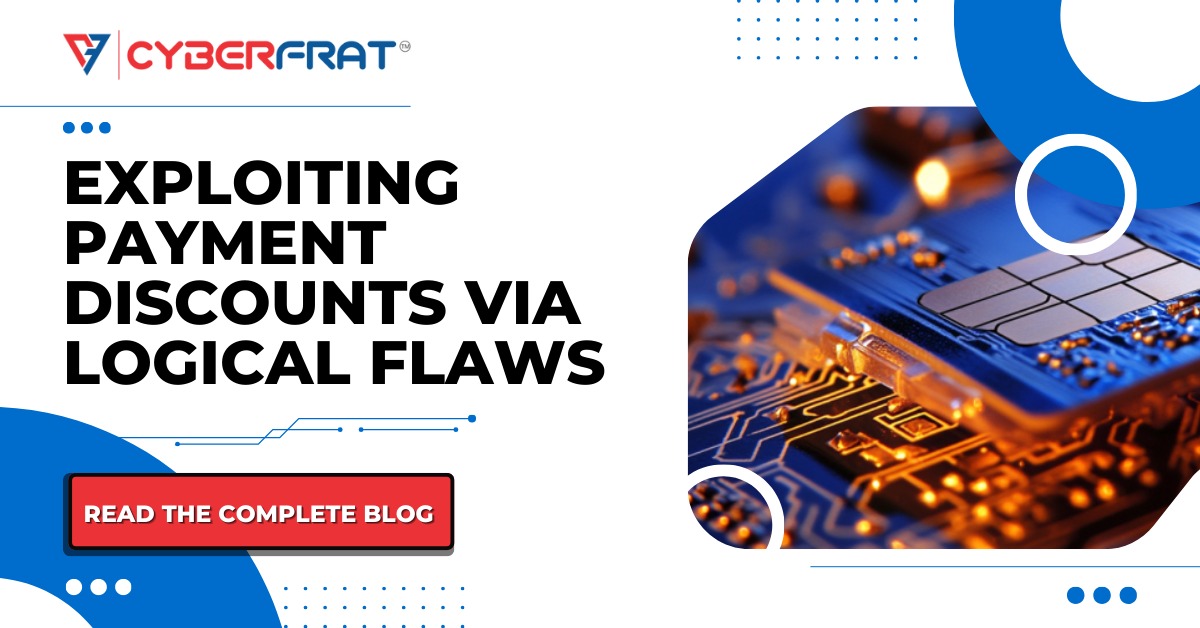
In today’s digital economy, payment systems are the backbone of financial transactions, ensuring seamless and secure exchanges. While technical attacks such as SQL injection or malware receive much attention, logical flaws—often stemming from poor design, inadequate testing, or oversight—can be just as damaging, if not more so. This blog explores how attackers exploit payment discounts through logical flaws, highlighting real-world examples and offering mitigation strategies

Logical flaws are mistakes in the way payment systems are set up or built. These mistakes can create weaknesses that let attackers take advantage of the system, like changing how discounts work to get more benefits than they should. These flaws are often subtle, overlooked during development, and can lead to severe financial and reputational consequences. Let’s explore some specific examples:
Sometimes, systems don’t properly check how discounts should be applied. For instance, discounts meant for certain products or specific customers might end up being applied to everything or everyone because the system doesn’t have enough rules in place to make sure the discount is applied correctly.
Example: An online store was offering a “20% off on electronics” discount. However, attackers found a way to trick the system by changing the checkout details. They applied the electronics discount to items that weren’t electronics, like furniture and appliances. As a result, the store lost a lot of money because expensive items were sold at a much lower price
Mitigation Tips:
1. Implement server-side validation to ensure discount codes are applied only to eligible products. Server-side validation means checking the discount codes on the server (instead of the user’s device) to make sure the code can only be used for the products that qualify for the discount.
2. Use conditional logic to restrict discounts based on product categories, user profiles, or promotional timelines. In simple terms, this means setting rules to control when and how discounts can be applied. For example, you can make sure that discounts are only available for certain types of products, certain users (like first-time buyers), or during specific time periods (like a holiday sale). This helps ensure discounts are given in the right situations.
3. Test discount scenarios rigorously during development.
Several payment systems allow multiple discounts to your purchase at the same time, which is called “stacking” discounts. If the order of application or eligibility criteria for stacking is not properly controlled, attackers can exploit this to maximize deductions.
Example: A retailer offered two concurrent discounts: “₹ 150 off orders above ₹ 1000” and “10% off sitewide.” Attackers manipulated the sequence of applying these discounts by intercepting API calls. They applied the ₹ 150 discount first, which reduced the total below ₹ 1000 but still allowed the 10% discount to apply, resulting in drastically reduced order amounts.
Mitigation Tips:
1. Define clear rules for how discounts can be combined and in what order they should be applied.
2. Enforce backend checks to prevent unintended stacking.
3. Use monitoring tools to flag unusual discount application patterns.
Attackers take advantage of timing issues or competition between different actions happening at the same time to change the contents of the shopping cart or the order during checkout. This lets them sneak in changes, like getting extra discounts or free items, before the system finishes processing everything.
Example: A grocery delivery service required a minimum purchase of ₹ 500 for free shipping. Attackers would add enough items to meet the threshold, apply the free shipping benefit, and then remove items from the cart before completing the purchase. The system failed to recheck the minimum purchase requirement after items were removed.
Mitigation Tips:
1. Use transaction locking mechanisms to prevent state changes during the checkout process.
2. Validate all conditions at the final step before payment processing.
3. Conduct race-condition testing to identify and fix timing-related flaws.
Attackers often target single-use discount codes or promo codes. If a website doesn’t properly manage user sessions or check the codes correctly, attackers can use the same code multiple times for different transactions or accounts, even though the code is supposed to be used only once.
Example: A food delivery app issued “first-time user” promo codes. Attackers created multiple accounts using disposable email addresses and reused the promo code by intercepting and replaying API requests. This exploit resulted in thousands of free or heavily discounted orders.
Mitigation Tips:
1. Link discount codes to unique identifiers like user IDs or transaction IDs.
2. Make sure user sessions are securely handled so that attackers can’t reuse or “replay” old session data to gain unauthorized access.
3. Monitor for patterns such as multiple accounts using the same IP address or device.
Modern payment systems often expose APIs for frontend-backend communication. If these APIs are not securely designed, they can become prime targets for exploitation.
Example: A gaming platform’s API exposed a “discount Amount” parameter, allowing users to specify the discount value. Attackers manipulated this parameter to apply unauthorized discounts, significantly reducing the cost of premium subscriptions and in-game purchases.
Mitigation Tips:
1. Validate all API inputs on the server side.
2. Restrict discount-related parameters to predefined values or ranges.
3. Regularly audit API endpoints for security vulnerabilities and ensure they adhere to secure design principles. In simple terms, this means checking the API (the way different software systems talk to each other) regularly to make sure it’s safe from security risks. You also need to make sure that it’s built using best practices for security to protect it from potential threats.
Logical flaws in payment systems represent a critical yet often underestimated category of vulnerabilities. Unlike technical exploits that leverage programming errors or configuration issues, logical flaws exploit gaps in business logic, workflows, and rules governing discount applications and payment processing. These vulnerabilities can lead to substantial financial losses, customer dissatisfaction, and reputational harm. Below, we delve into the detailed implications and consequences of these flaws.
Logical flaws frequently allow attackers to manipulate discount systems, either by applying discounts in unintended ways or bypassing restrictions altogether. For example, improperly validated promo codes can be exploited repeatedly, or attackers can stack discounts to achieve excessive deductions. The financial impact is immediate and often significant, particularly when high-value items are involved.
When logical flaws become public, they can erode customer trust. Users might lose confidence in the platform’s ability to secure transactions or view the business as unreliable. Competitors may also leverage such incidents to their advantage.
Logical flaws often point to broader problems within the organization’s software development lifecycle. These include insufficient security reviews, inadequate testing for edge cases, and a lack of coordination between development and security teams.
Logical flaws in payment systems require a proactive, layered approach to prevention and mitigation. While traditional vulnerabilities may be addressed through patches and updates, logical flaws demand a deeper understanding of the system’s workflows and design principles. Below are comprehensive strategies to mitigate these vulnerabilities effectively:
· Make sure to carefully check the code that handles how payments are processed, how discounts are applied, and how the system communicates with other services through APIs. This ensures everything works correctly and securely.
· Make sure that team members review each other’s work regularly during the development process to catch any possible mistakes or logical problems early on.
· Use tools that automatically check the code both for errors while the program is running (dynamic analysis) and without running it (static analysis). This will help find issues that might be missed during manual reviews.
· Embed security into the design phase by adopting Secure Software Development Lifecycle (SDLC) practices.
· Define and implement business logic constraints at both the application and database levels to prevent misuse.
· Utilize input validation techniques to ensure that only valid and expected data is processed.
· Simulate realistic attack scenarios to identify potential vulnerabilities during quality assurance testing.
· Incorporate automated testing frameworks to validate discount logic, workflow constraints, and state transitions under various conditions.
· Perform regression testing after every significant change to the codebase.
· Deploy advanced monitoring tools to track anomalies in payment workflows and discount applications.
· Set up alerts for patterns such as unusually high-frequency API calls, repeated discount usage, or inconsistent transaction states.
· Utilize AI-driven analytics to detect complex logical abuse patterns that might escape conventional monitoring.
· Develop and maintain an incident response plan tailored to logical flaw exploitation scenarios.
· Establish processes for rapid containment, root cause analysis, and remediation of detected issues.
· Ensure all relevant teams are trained on handling incidents involving logical flaws.
· Schedule periodic security audits focusing on business logic and payment workflows.
· Engage external security experts or penetration testers to uncover flaws that internal teams might overlook.
· Include comprehensive testing of API endpoints, discount logic, and checkout workflows.
· Enforce Role-Based Access Controls (RBAC) to restrict who can create, modify, or apply discounts.
· Implement rate limiting and throttling on APIs to prevent abuse through high-frequency requests.
· Use multi-factor authentication (MFA) for administrative and high-privilege operations.
· Conduct regular training sessions for developers, quality assurance teams, and business analysts on identifying and mitigating logical flaws.
· Foster a culture of security awareness across all teams involved in the payment system lifecycle.
· Provide resources and tools to help teams stay updated on the latest trends in logical flaw exploitation.
Logical flaws represent a silent yet potent threat to modern payment systems. Their exploitation can lead to significant financial loss, reputational damage, and operational disruptions. By adopting a security-first mindset and implementing robust strategies—including comprehensive code reviews, proactive testing, and continuous monitoring—organizations can fortify their systems against these vulnerabilities. The path to resilience lies in viewing security as an integral part of the development lifecycle, ensuring that every transaction remains secure and trustworthy.
For more Visit our website https://learn.cyberfrat.com/
Written By
Tamanna Agrawal
Assistant Manager – Operations, CyberFrat